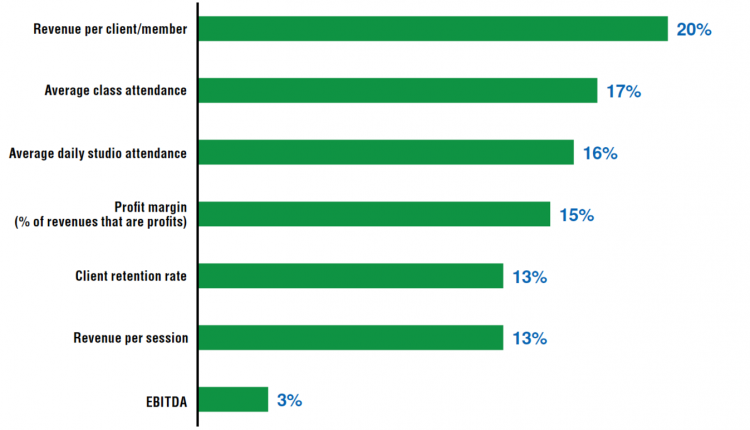
In the fitness studio industry, there are at least a dozen valuable KPIs (Key Performance Indicators) to consider. We’ve selected the top 5 based on the Association of Fitness Studios (AFS) research, which is a valuable resource to gain a full understanding of the flow of your business.
The graph shown below, from the Association of Fitness Studios 2016 Operating & Financial Benchmarking Report details the KPIs of primary focus for fitness studios of all sizes and disciplines.

*Source: Association of Fitness Studios 2016 Operations & Financial Benchmarking Research Report
1 – Revenue per client/member (RPC)
The most common, and probably the easiest KPI to track is Revenue Per Client – a measure of productivity. A simple calculation (annual revenue divided by number of clients).
For example, you generate $300,000 annually and you have 300 clients, then your RPC is $1,000, roughly the industry average. (That’s right. The average client is worth $1,000 per year!)
Besides access to classes and/or membership dues, what else can you make available for sale to your clients? What do they want? What would be a complementary product or service that would enhance enjoyment without seeming too aggressive?
2 – Average Class Attendance (ACA)
Another popular KPI, not surprisingly, is Average Class Attendance (ACA). If classes are full or nearly so, it indicates a highly desired class, and theoretically, a profitable class.
At the other end of the spectrum, some classes are not quite as full. It’s incumbent on the owner to find out why; often an elusive answer. It’s key to know the difference between:
·A bad class
·A bad instructor
·A bad day or time
3 – Client Retention Rate (CRR)
Retention - the percentage of clients you retain - is critical to long-term profitability. In many ways, it’s the most important KPI of all because it measures how well you’re delivering on your brand promise.
Typical CRR for the studio industry is roughly 72%. So, what do you do to increase that number?
Focus on marketing strategies, tactics, messaging, time and expenditure along with ongoing sales efforts. Retain your clients by:
·Make sure those who work in your studio (whether employee or independent contractor) have embraced your vision.
·Understand why clients are leaving. Do exit interviews. Let them know you value their opinion.
4 – Profit Margin (PM)
If it costs you more to generate the revenue than the revenue you generate – that’s a negative PM and your business is not long for this world. That is, unless you’re incredibly well financed and have deep pockets.
If not, turn your attention to where and how you’re spending your money. Where is your money going? Which expenses are out of control? Which are necessary expenditures and which are not? Which expenses help generate revenue?
And don’t overlook the revenue side of the coin. Are you charging enough for this or for that? Does your pricing model need revision? Are your programs stale?
5 – Average Daily Attendance (ADA)
A simple KPI but one that can get blurry. Is your studio full of Class Passers who pay next to nothing and have no intention of ever joining your studio or paying full price for a class? Good for Average Daily Attendance, terrible for Profit Margin or Client Retention Rate.
There are lots of methods to achieve your ADA goal. Give away free promo items, run special promotions, bring a friend, special this or that are all ideas. But be careful. While there’s validity to ADA as a marketing strategy, make sure there’s a sales acquisition strategy to support it.
Try this
Write down on a piece of paper every aspect of your business – from marketing to recording keeping, order supplies – anything you can think of.
Now write down the number “1” next to each. On the other side of the paper, the number “10.” Go through each one and grade yourself 1-10, with 10 being awesome and 1 being needs improvement.
Those that rank 6-10, leave alone. Those from 4-6, same thing (for now). Focus on those that are 1-3 and determine how you can get better there. Chances are, if those areas are suffering then other areas of your business are being affected as well.











